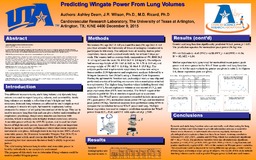| dc.contributor.author | Deam, Ashley | |
| dc.date.accessioned | 2017-04-13T18:26:23Z | |
| dc.date.available | 2017-04-13T18:26:23Z | |
| dc.date.issued | 2015 | |
| dc.identifier.uri | http://hdl.handle.net/10106/26603 | |
| dc.description | KINE 4400 | en_us |
| dc.description.abstract | INTRODUCTION: Two different measurements, static lung volume and dynamic lung volume are used to report lung size, volume, and contractility. Spirometric
Respiratory Tests are one way to measure these different lung values. Anaerobic Power is used for short bursts of high intensity power and is mainly measured using the
Wingate Anaerobic Test (WAnT). The relationship between lung function and anaerobic power in healthy individuals is not completely understood.
PURPOSE: The purpose of this study was to determine if lung volumes could be used to predict Wingate power.
METHODS: Six women (W; age 24.7 ± 4.8 yrs.) and five men (M; age 24.2 ± 4.4 yrs.) that attended the University of Texas at Arlington, volunteered to participate in
this study. The subjects performed a spirometric respiratory function test followed by a Wingate Anaerobic Test (WAnT). During the spirometric function test, each
subject wore a nose clip and performed a series of breathing maneuvers into a mouthpiece attached to a spirometer. Lung function values including forced vital capacity
(FVC), forced expiratory volume at one second (FEV1), and peak expiratory flow (PEF) were recorded. The WAnT required for subjects to pedal for 30 s at maximum
speed against a constant resistance. The WAnT power parameters recorded include mean power (W), peak power (W), normalized mean power (W/kg), and normalized
peak power (W/kg)). Statistical analyses were performed using SPSS to compute the correlation between WAnT power and lung. Multiple linear regression was used to
compute prediction equations for WAnT power from FEV1, PEF, and FVC with alpha set at 0.05.
RESULTS: Gender and lung function significantly predicted WAnT power, p < 0.05.
The prediction equation for normalized peak power (W/kg) was
PP = 4.12(Gender) −4.45 (FVC) + 6.58 (FEV1) −1.61(PEF) + 11.54, R2 = .82, SEE = 1.54.
Similar equations were generated for normalized mean power, peak power and mean power in the WAnT from gender and lung function. Mean ± SD for each variable
by gender were: FVC (W: 4.0 ± 0.9 L, M: 5.3 ± 1.1 L), FEV1 (W: 3.1 ± 0.6 L/sec, M: 3.6 ± 1.3 L/sec), PEF (W: 4.9 ± 1.8 L/min, M: 5.4 ± 2.8 L/min) and Wingate
power parameters: MP (W: 395.8 ± 50.2 W, M: 586.8 ± 116.1 W), PP (W: 671.7 ± 123.5 W, M: 879.6 ± 228.2 W), MP/Wkg (W: 5.85 ± 0.6 W/Kg, M: 7.0 ± 2.0 W/Kg),
PP/Wkg (W: 10.0 ± 2.4 W/Kg, M: 10.6 ± 3.6 W/Kg)).
CONCLUSION: The results of this study indicate that lung volumes can be used to predict Wingate power in both men and women. Lung function and gender
significantly explained 82 – 94% of the variance in Wingate power variables. | en_US |
| dc.description.sponsorship | Faculty Sponsor, J.R. Wilson | en_US |
| dc.description.sponsorship | Faculty Sponsor, M.D. Ricard | en_us |
| dc.language.iso | en_US | en_US |
| dc.subject | spirometric respiratory function test | en_US |
| dc.subject | Wingate Anaerobic Test (WAnT) | en_US |
| dc.subject | forced expiratory volume at one second (FEV1) | en_US |
| dc.subject | peak expiratory flow (PEF) | en_US |
| dc.title | Predicting Wingate Power From Lung Volumes | en_US |
| dc.type | Presentation | en_US |
| dc.publisher.department | Department of Kinesiology, The University of Texas at Arlington | en_us |
| dc.publisher.department | Exercise Science Research Laboratories, The University of Texas at Arlington | en_us |
| dc.publisher.department | Cardiovascular Research Laboratory, The University of Texas at Arlington | en_us |


